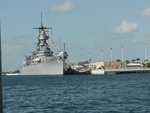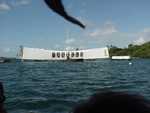| |

Aloha! We are reporting today from beautiful Honolulu. I want to thank all of you who continue to send us emails with your questions and comments about our trip. We look forwarding to visiting Mr. Weltner's fifth grade class in Cranberry Township, Pennsylvania on Thursday to answer all the students' questions in person.
When we figured out our travel plans to Micronesia, we discovered we could go home a different way than we had come, flying on what is called an "island hopper" flight. The plane stopped on several islands in the FSM and Marshall Islands on the way to Hawaii. This route gave us a one-day layover in Honolulu before we had to catch our last flight home.
Our mission today was to learn more about World War II. We wanted to find out what events led up to Pearl Harbor, about the attack on Pearl Harbor itself, and about America's entrance into WWII. We learned some answers by visiting the USS Arizona Memorial. We also had enough time to see the USS Bowfin, a submarine docked in Pearl Harbor, and the USS Missouri, a battleship that served in three wars. I'll tell you about the Arizona Memorial, and Tom will tell you about the other ships.
Events Leading Up to Pearl Harbor
The attack on Pearl Harbor was the result of deteriorating relations between Japan and the U.S. For a decade, the two countries had been quarreling over the status of China and the security of Southeast Asia. The disputes began in 1931 when certain members of the Japanese army disobeyed government policy and invaded the northernmost province of China called Manchuria. In the summer of 1937, Japan launched a full-scale attack on the rest of China. Although the U.S. and other nations were alarmed by Japan's actions, no one was willing to pick a fight with the Japanese. By 1941, Japan had taken control of Malaysia, China, the Philippines, French Polynesia, and all of Micronesia, including Guam.
Over the next three years, war broke out in Europe. Japan joined Nazi Germany as a member of the Axis Alliance. Meanwhile, the U.S. avoided military conflict, but used other means, such as diplomatic and economic pressures, to try to resolve the issue of Japanese control over China. The Japanese government viewed these measures, especially an embargo on oil, as threats to their nation's security.
By the summer of 1941, the U.S. and Japan had come to a stalemate. Both countries had put themselves on the line, and had taken hard stances from which they could not retreat without losing face. Although both governments continued attempting to negotiate a solution, Japan had already decided on war.
The attack on Pearl Harbor was part of Japan's wartime strategy to conquer the Western Pacific. They aimed to paralyze the U.S. Pacific Fleet so that the U.S. could not interfere with Japanese invasion plans. Admiral Isoruku Yamamoto was the commander of the Japanese fleet that attacked Pearl Harbor. He knew that Japan's only chance at winning a war with the U.S. was to achieve a quick and decisive victory. Yamamoto believed that if Japan had to fight a long, drawn-out war, the U.S.'s superior economic and industrial power would prevail (which is exactly what ended up happening).
The Attack on Pearl Harbor
Tom and I learned what happened during the attack on Pearl Harbor by watching a movie shown at the memorial today. The incredible movie contained actual footage from the attack on Pearl Harbor. It was very moving and powerful to see. I'll try to explain in words the unbelievable events I saw portrayed in the movie.
The attack on Pearl Harbor took place on December 7, 1941. At 6 a.m. the first wave of fighter, bomber, and torpedo planes took off. The night before, five midget submarines (two men inside each) were launched into Pearl Harbor, poised to cause as much damage as possible once the air strike began.
(Click on any photo to enlarge it.)
 Meanwhile, the 130 vessels of the U.S. Pacific Fleet lay calm and serene. Seven of the fleet's nine battleships were tied up in a row in the harbor -- basically large, sitting targets. Because of a series of mistakes by the U.S. Armed and Naval Forces, the Japanese fleet of 33 warships and 185 planes was able to attack an unsuspecting U.S. fleet at Pearl Harbor. At 7:55 a.m. the Japanese fleet received the message that the attack had begun and that they had completely surprised the Americans.
Meanwhile, the 130 vessels of the U.S. Pacific Fleet lay calm and serene. Seven of the fleet's nine battleships were tied up in a row in the harbor -- basically large, sitting targets. Because of a series of mistakes by the U.S. Armed and Naval Forces, the Japanese fleet of 33 warships and 185 planes was able to attack an unsuspecting U.S. fleet at Pearl Harbor. At 7:55 a.m. the Japanese fleet received the message that the attack had begun and that they had completely surprised the Americans.
More than 2,300 Americans lost their lives in the attack on Pearl Harbor. More than 1,100 died when the Japanese sunk the USS Arizona, a battleship anchored there. The battleship was hit in the forward ammunition magazine by a Japanese bomb. In the movie we saw today, the ship exploded when the ammunition ignited, and sank in less than nine minutes. It is hard to describe the powerful imagery of watching the Arizona explode and sink. Because this singular hit was so tragic, the U.S. decided to leave the Arizona where it fell, preserving the memory of the soldiers who died on board.
The attack on Pearl Harbor was a great but not total success for the Japanese. Although the U.S. Pacific Fleet was shattered, its aircraft carriers (not in port at the time of the attack) were still afloat and the harbor itself was intact. The shipyards, fuel storage areas, and submarine base were hardly damaged.
America Enters WWII
Before the battle at Pearl Harbor, there were many people who didn't want the U.S. to get involved in the war. After the bombing, however, American people rallied together to support the U.S. in its fight against Japan and her Axis partners. The turning tide of support for WWII was perhaps the most important result of the Japanese attack on Pearl Harbor.
To get a good sense of American sentiments after the Pearl Harbor bombing, read the speech President Roosevelt gave the morning after the attack. It will fascinate you. Here is a link that will take you right to his plea to Congress.
bcn.boulder.co.us/government/national/speeches/spch2.html
The USS Arizona Memorial
 After the movie, Tom and I rode a ferryboat out to the memorial. The memorial consists of a large, white concrete structure that sits above the sunken ship. Inside, there are two rooms: an area where you can view the ship below, and the "shrine room." From the monument you can see the USS Missouri docked nearby.
After the movie, Tom and I rode a ferryboat out to the memorial. The memorial consists of a large, white concrete structure that sits above the sunken ship. Inside, there are two rooms: an area where you can view the ship below, and the "shrine room." From the monument you can see the USS Missouri docked nearby.
Although the Arizona is at the bottom of Pearl Harbor, you can see parts of the ship's gun turrets still above the water line. In fact, the top of the ship is only a few feet below the water's surface. From time to time, small amounts of oil leak from the Arizona's engines and the oil slick sometimes forms a small rainbow on the water's surface. We saw a small slick today.
We could see much of the ship below the surface of the water and some parts above. Listed in the shrine room of the memorial are the names of all the men who died and are buried in the ship below. It is a somber place. Many visitors brought leis (strings of flowers) and bouquets of flowers to drop into the water to commemorate the crew of the Arizona.
I thought about all the remnants of war and death we have seen this last week, first at Chuuk Lagoon and today at Pearl Harbor. These are hard things to think about, but they made me realize how lucky we are to be living in a time of peace for our country, and to long and hope for peace all over the world.
Signing off until the next adventure,
Karen
|


